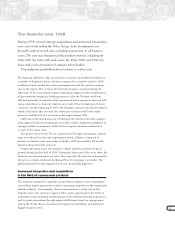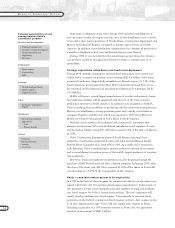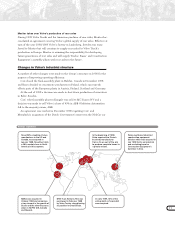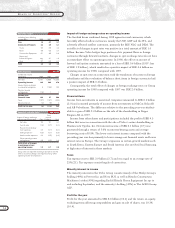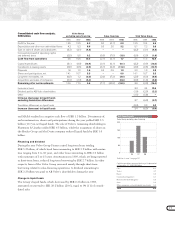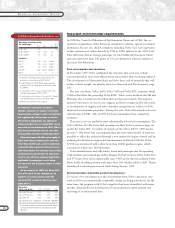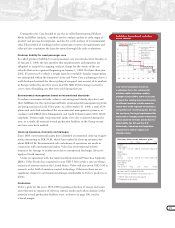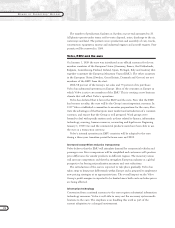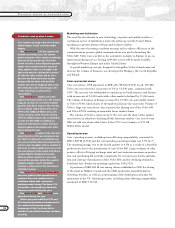Volvo 1998 Annual Report Download - page 21
Download and view the complete annual report
Please find page 21 of the 1998 Volvo annual report below. You can navigate through the pages in the report by either clicking on the pages listed below, or by using the keyword search tool below to find specific information within the annual report.
The Biofidelic Rear Impact Dummy
(BioRID) was unveiled in 1998 following
more than three years of research. The
dummy, which is designed to provide
better knowledge of the ways so-called
whiplash injuries occur and can be
reduced, is equipped with a spine consis-
ting of 24 rigid vertebrae joined by articu-
lated metal welds. These vertebrae are
shaped as torsion bars in the thoracic
region, while movement in the neck
section is determined by a combination of
damping elements and “surrogate
muscles” in the form of longitudinal
cables.
Simulations of molding, performed in a
supercomputer, can now replace practical
experience. As a result, during the initial
phases of development of a new product,
the production processe can be simulated
and tested in a computer, which in turn
means high quality and reduces lead
times and costs.
19
Over the course of years Volvo has displayed a number of advanced concept
vehicles and in 1999 it plans to introduce this technology for tests in buses and
distribution vehicles that will be used in regular traffic for three years to provide
practical experience.
Safety
Safety cannot be compromised within Volvo and always has the highest priority
in all design work. Volvo’s research program has been expanded to include active
safety, biomechanics and behavioural science in addition to traditional passive
safety. There is also a focus on what happens in the course of a collision between
a passenger car and a truck, and when a car hits a pedestrian.
In the area of active safety, development work is taking place mainly in infor-
mation technology (IT) and control systems, the objective being to prevent the
occurrence of accidents. The ability to prevent drivers from falling asleep at the
wheel is a notable example.
Volvo is building a new safety system that will make it possible to conduct
collision tests of cars and commercial vehicles, as well as to simulate accidents
between cars and trucks.
Electronics and control systems
A well-developed, functional structure for the electronic system of a vehicle is
essential for the control systems that are being introduced with the objective of
reducing greenhouse gases, improving safety and increasing mobility. During
1998 Cars and Trucks introduced advanced multiplex electronic systems that can
be supplemented in the future with additional functions such as an integrated
system for the drive line in which the interaction of the engine and the gearbox
is improved to achieve optimal performance.
Virtual vehicles and development processes
Development of a vehicle is a complicated task that involves integrating a large
number of components and systems with many complex interfaces between
components and different suppliers. This has traditionally resulted in long devel-
opment periods and a large number of prototype vehicles. Volvo is increasingly
changing over to the use of IT and simulation tools, which means that both
vehicle and concept can be developed, studied, tested and refined in a computer
– a so-called virtual vehicle – before a vehicle is built. One or two generations of
prototypes can thus be eliminated and, once a prototype is built it will be of
higher quality and much closer to a finished product. As part of this develop-
ment Volvo is conducting research on advanced simulation techniques, including
shaping and flow simulations that will replace wind tunnel tests.
BioRID
Molding


